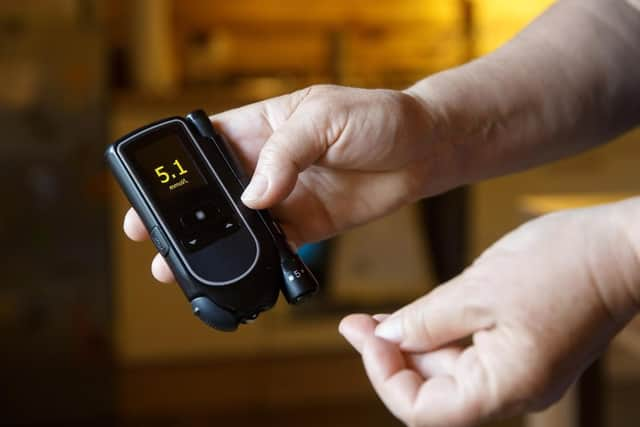Diabetes in Wakefield: How many people have undiagnosed diabetes in my area - and what are the symptoms?
and live on Freeview channel 276
And analysis of official data reveals this includes hundreds in Wakefield.
Diabetes UK said around 850,000 people in the UK are thought to have type 2 diabetes but have not had a formal diagnosis.
Advertisement
Hide AdAdvertisement
Hide AdSeparate analysis by NHS Wakefield and government data reveals there are an estimated 500 undiagnosed diabetics in Wakefield - with most of these likely to have type 2.


There are a total of 24,795 known diabetics, type 1 and type 2, in the district.
A spokesperson for Diabetes UK said undiagnosed diabetes risks serious complications.
Senior clinical advisor Emma Elvin said: “Early diagnosis is the best way to avoid the devastating complications of type 2 diabetes, and offers the best chance of living a long and healthy life with the condition.
Advertisement
Hide AdAdvertisement
Hide Ad“Type 2 diabetes can sometimes go undetected for up to 10 years. While the symptoms can sometimes be tricky to spot in the early stages, it’s important to know the signs to look out for, and if you notice anything unusual, speak to your GP.
“We urge anyone concerned about type 2 diabetes to use Diabetes UK’s free online Know Your Risk tool. It could be the vital first step towards getting a diagnosis and getting the right care to stay healthy.”
Diabetes leads to almost 9,600 leg, toe or foot amputations every year across the UK, according to the charity.
It is also one of the country’s leading causes of preventable sight loss. More than 1,700 people have their sight seriously affected by their diabetes every year.
Advertisement
Hide AdAdvertisement
Hide AdType 2 diabetes is far more common than type 1, and accounts for around 90% of all adult cases in the UK.
The lifelong condition is caused by problems with the production of insulin in the body and is often linked to being overweight or inactive, or having a family history of type 2 diabetes.
It causes the level of glucose in the blood to become too high and can lead to a variety of serious health conditions, such as heart disease or a stroke.
The longer people with type 2 diabetes are undiagnosed, the higher their risk of serious complications.
Advertisement
Hide AdAdvertisement
Hide AdMany people have the condition without realising as symptoms do not necessarily make you feel unwell, making the disease difficult to spot.
However, there are a few telltale signs to look for that could be a warning sign of type 2 diabetes.
What are the symptoms of type 2 diabetes?
Two common symptoms of high blood sugar - also known as hyperglycaemia - can be evident in the mouth. These include a dry mouth and a breath that smells “fruity”, according to the NHS.
Other symptoms that could be a sign of type 2 diabetes include:
Weeing more than usual, particularly at night
Feeling thirsty all the time
Feeling very tired
Losing weight without trying to
Advertisement
Hide AdAdvertisement
Hide AdItching around your penis or vagina, or repeatedly getting thrush
Cuts or wounds taking longer to heal
Blurred vision
Symptoms of hyperglycaemia in people with diabetes tend to develop slowly over a few days or weeks, and in some cases symptoms will not appear until blood sugar levels are very high.
Hyperglycaemia symptoms can also be caused by undiagnosed diabetes, so the NHS advises seeing a GP if this applies to you.
Who is most at risk of type 2 diabetes?
According to the NHS, you are more at risk of developing type 2 diabetes if you:
Are over 40 (or 25 for south Asian people)
Advertisement
Hide AdAdvertisement
Hide AdHave a close relative with diabetes, such as a parent, brother or sister
Are overweight or obese
Are of Asian, African-Caribbean or black African origin, even if you were born in the UK
Type 2 Diabetes Prevention Week begins on Monday, May 23. Research shows that for some people, combined lifestyle changes to their weight, diet and physical activity levels can cut the risk of type 2 diabetes by about 50%.
How is type 2 diabetes treated?
Most people will need medicine to control their type 2 diabetes. This will help to keep blood sugar levels as normal as possible to prevent further health problems and may need to be taken for the rest of your life.
Advertisement
Hide AdAdvertisement
Hide AdA healthy diet and keeping active can also help to manage your blood sugar levels.
The NHS recommends eating a wide range of foods, including fruit, vegetables and starchy foods like pasta, and keeping sugar, fat and salt to a minimum. Around 2.5 hours of physical activity is also advised per week.
There is evidence that eating a low-calorie diet of 800 to 1,200 calories a day on a short-term basis (around 12 weeks) can help with symptoms of type 2 diabetes, and some people have found that their symptoms go into remission.
However, a low-calorie diet is not safe or suitable for everyone with type 2 diabetes, such as those who need to take insulin, so it is important to seek medical advice before going on this type of diet.